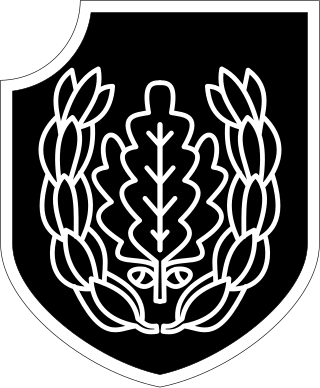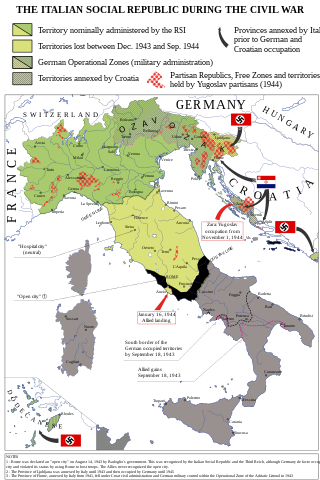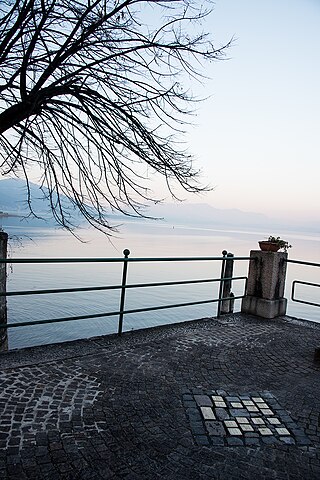Related Research Articles

The Waffen-SS was the combat branch of the Nazi Party's paramilitary Schutzstaffel (SS) organisation. Its formations included men from Nazi Germany, along with volunteers and conscripts from both German-occupied Europe and unoccupied lands. It was disbanded in May 1945.

The German 23rd Infantry Division, later the 26th Panzer Division, was a military unit operational during World War II. It was organized along standard lines for a German infantry division. It was non-motorised and relied on horse-drawn wagons for its mobility. The unit carried the nickname Grenadierkopf.
The Fallschirm-Panzer-Division 1. Hermann Göring was a German Luftwaffe armoured division. The HG saw action in France, North Africa, Sicily, Italy and on the Eastern Front during World War II. The division began as a battalion-sized police unit in 1933. Over time it grew into a regiment, brigade, division, and finally was combined with the Parachute-Panzergrenadier Division 2 Hermann Göring on 1 May 1944 to form a Panzer corps under the name Reichsmarschall. It surrendered to the Soviet Army near Dresden on 8 May 1945.

The 334th Infantry Division was a German Army infantry division in World War II. Originally formed in November 1942, it surrendered to the Allies at the conclusion of the Tunisian Campaign in May 1943. The division was reconstituted on 3 June 1943 in France within the 1st Army, with the staff of the 80th Infantry Division as well as remnants of the old division and replacement units. It spent the remainder of the war serving on the Italian Front.

The 29th Infantry Division was a unit of the German army created in the fall of 1936. It was based on the old Reichswehr 15th Infantry Regiment and drew its initial recruits from Thuringia. It was upgraded to 29th Motorized Infantry Division in the fall of 1937. The division was also known as the Falke-Division.

The 3rd Infantry Division was an infantry division of the German Army that fought in World War II. The division was established under the cover name Wehrgauleitung Frankfurt in 1934 by expanding the 3rd Division of the Reichswehr. It was redesignated Kommandant von Frankfurt shortly afterward, and took on its bona fide name when the formation of the Wehrmacht was announced in October 1935. In March 1939 the division took part in the invasion and occupation of Czechoslovakia.

The 16th SS Panzergrenadier Division "Reichsführer-SS" was a motorised infantry formation in the Waffen-SS of Nazi Germany during World War II.

The 24th Waffen Mountain Division of the SS "Karstjäger" was a German mountain infantry division of the Waffen-SS, the armed wing of the German Nazi Party that served alongside, but was never formally part of, the Wehrmacht during World War II. At the post-war Nuremberg trials, the Waffen-SS was declared to be a criminal organisation due to its major involvement in war crimes and crimes against humanity. Named Karstjäger, the formation was one of the 38 divisions fielded by the Waffen-SS. Formed on 18 July 1944 from the SS Volunteer Karstwehr Battalion, its nominal strength was never more than theoretical and the division was soon reduced to the Waffen Mountain (Karstjäger) Brigade of the SS. Throughout its existence as a battalion, division and brigade, it was primarily involved in fighting partisans in the Karst Plateau on the frontiers of Yugoslavia, Italy, and Austria; the mountainous terrain required specialised mountain troops and equipment.

The 162nd Turkistan Division was a military division that was formed by the German Army during the Second World War. It drew its men from prisoners of war who came from the Caucasus and from Turkic lands further east.

42nd Jäger Division was a light infantry formation of the German Army during World War II. It can trace its origins to the 187th Infantry Division which was based in Austria until September 1942, when it was redesignated as the 187th Reserve Division. The 187th was sent to Croatia and was redesignated the 42nd Jäger Division in January 1944. 42. Jäger-Division was formed 22 Dec 1943 in Croatia from the 187. Reserve-Division. After taking part in Operation Margarthe, in March 1944, and then returned to Yugoslavia in May. In July 1944 the division was transferred to Italy where it remained for the rest of the war and surrendered in April 1945.

114th Jäger Division was a light infantry division of the German Army in World War II. It was formed in April 1943, following the reorganization and redesignation of the 714th Infantry Division. The 714th Division had been formed in May 1941, and transferred to Yugoslavia to conduct anti-partisan and Internal security operations. It was involved in Operation Delphin which was an anti-partisan operation in Croatia that took place between 15 November and 1 December 1943. The objective of the mission was to destroy the Partisan elements on the Dalmatian islands off central Dalmatia.

Wilhelm Schmalz was a German general (Generalleutnant) in the Wehrmacht during World War II and a recipient of the Knight's Cross of the Iron Cross with Oak Leaves of Nazi Germany. Schmalz surrendered to American troops in May 1945.

The 65th Infantry Division was a German division in World War II. It was formed in July 1942.
The 278th Infantry Division German: 278. Infanterie-Division was a German Army infantry division in World War II. Formed in 1940 from older personnel, the first 278th never saw combat and was dissolved after the fall to France. The second 278th was formed in mid 1942 in Belgium and was sent to Army Group C Italy in late 1943.
The 362nd Infantry Division was an infantry division of the German Army during the Second World War, active from 1943 to 1945. Formed in Italy, it participated in the Italian Campaign for the entire duration of its war service. It was implicated in the massacre of 97 civilians in what is known as the Benedicta massacre, which occurred at Piedmont in April 1944.

Two of the three major Axis powers of World War II—Nazi Germany and their Fascist Italian allies—committed war crimes in the Kingdom of Italy.
The Vinca massacre was a massacre carried out near Fivizzano, Tuscany, by the German 16th SS Panzergrenadier Division from 24 to 27 August 1944 in which 162 Italian civilians were killed.
The San Terenzo Monti massacre, sometimes also referred to as the Bardine massacre or Bardine San Terenzo massacre, was a massacre carried out near Fivizzano, Tuscany, by the German 16th SS Panzergrenadier Division from 17 to 19 August 1944 in which 159 Italian civilians were killed.

The Lake Maggiore massacres was a set of World War II war crimes that took place near Lake Maggiore, Italy, in September and October 1943. Despite strict orders not to commit any violence against civilians in the aftermath of the Italian surrender on 8 September 1943, members of the 1st SS Panzer Division Leibstandarte SS Adolf Hitler murdered 56, predominantly Italian and Greek, Jews. Many of the bodies were sunk into the lake to prevent discovery but one washed ashore in neighbouring Switzerland, drawing international attention to the massacre and prompting an inconclusive divisional inquiry. It is commonly referred to as the first German massacre of Jews in Italy during World War II.
References
- 1 2 "List of units" (in Italian). Atlas of Nazi and Fascist Massacres in Italy. Retrieved 20 September 2018.
- ↑ Gentile, p. 1
- ↑ Armellini, Arvise (5 April 2016). "New Study: Number of Casualties in Nazi Massacres in Italy Nearly Double as Previously Believed". Haaretz . Retrieved 16 August 2018.
- ↑ Jowett, The Italian Army 1940-43 (3), p. 24
- ↑ Neitzel, Sönke. "Book Review by Sönke Neitzel in War in History: Wehrmacht und Waffen-SS im Partisanenkrieg: Italien 1943-1945". University of Cologne . Retrieved 16 September 2018.
- ↑ "Military Courts". Atlas of Nazi and Fascist Massacres in Italy. Retrieved 18 September 2018.
- ↑ Gentile, pp. 4 & 5
- ↑ "BOVES, 19.09.1943" (in Italian). Atlas of Nazi and Fascist Massacres in Italy. Retrieved 20 September 2018.
- ↑ "Meina" (in German). Gedenkorte Europa 1939–1945. Retrieved 29 September 2018.
- ↑ "1. SS-Panzer Division Leibstandarte Adolf Hitler" (in Italian). Atlas of Nazi and Fascist Massacres in Italy. Retrieved 20 September 2018.
- ↑ "ACERRA 01-03.10.1943" (in Italian). Atlas of Nazi and Fascist Massacres in Italy. Retrieved 20 September 2018.
- ↑ "Napoli 1-10-1943" (in Italian). Atlas of Nazi and Fascist Massacres in Italy. Retrieved 20 September 2018.
- ↑ "MONCHIO SUSANO E COSTRIGNANO PALAGANO 18.03.1944" (in Italian). Atlas of Nazi and Fascist Massacres in Italy. Retrieved 20 September 2018.
- ↑ "VALLUCCIOLE PRATOVECCHIO STIA 13.04.1944" (in Italian). Atlas of Nazi and Fascist Massacres in Italy. Retrieved 20 September 2018.
- ↑ "CIVITELLA IN VAL DI CHIANA 29.06.1944" (in Italian). Atlas of Nazi and Fascist Massacres in Italy. Retrieved 20 September 2018.
- ↑ "CAVRIGLIA 04.07.1944" (in Italian). Atlas of Nazi and Fascist Massacres in Italy. Retrieved 20 September 2018.
- ↑ "Fallschirm-Panzer-Division "Hermann Goring"" (in Italian). Atlas of Nazi and Fascist Massacres in Italy. Retrieved 20 September 2018.
- ↑ "PIETRANSIERI ROCCARASO 21.11.1943" (in Italian). Atlas of Nazi and Fascist Massacres in Italy. Retrieved 20 September 2018.
- ↑ "1. Fallschirmjäger-Division" (in Italian). Atlas of Nazi and Fascist Massacres in Italy. Retrieved 20 September 2018.
- ↑ "2. Fallschirm-Jäger-Division" (in Italian). Atlas of Nazi and Fascist Massacres in Italy. Retrieved 20 September 2018.
- ↑ "3. Panzer Grenadier Division" (in Italian). Atlas of Nazi and Fascist Massacres in Italy. Retrieved 20 September 2018.
- ↑ "Pedescala Valdastico 30.4.1945-2.5.1945" (in Italian). Atlas of Nazi and Fascist Massacres in Italy. Retrieved 20 September 2018.
- ↑ "4. Fallschirm-Jäger-Division" (in Italian). Atlas of Nazi and Fascist Massacres in Italy. Retrieved 20 September 2018.
- 1 2 "Grugliasco, 30.04.1945" (in Italian). Atlas of Nazi and Fascist Massacres in Italy. Retrieved 20 September 2018.
- ↑ "5. Gebirgs-Division" (in Italian). Atlas of Nazi and Fascist Massacres in Italy. Retrieved 20 September 2018.
- ↑ "cava di Bellona, 07.10.1943" (in Italian). Atlas of Nazi and Fascist Massacres in Italy. Retrieved 20 September 2018.
- ↑ "15. Panzer-Grenadier-Division" (in Italian). Atlas of Nazi and Fascist Massacres in Italy. Retrieved 20 September 2018.
- ↑ "San Clemente di Caserta, Caserta, 4/10/1943" (in Italian). Atlas of Nazi and Fascist Massacres in Italy. Retrieved 20 September 2018.
- ↑ "16. Panzer-Division" (in Italian). Atlas of Nazi and Fascist Massacres in Italy. Retrieved 20 September 2018.
- ↑ "SANT'ANNA DI STAZZEMA 12.08.1944" (in Italian). Atlas of Nazi and Fascist Massacres in Italy. Retrieved 20 September 2018.
- ↑ "SAN TERENZO MONTI FIVIZZANO 17-19.08.1944" (in Italian). Atlas of Nazi and Fascist Massacres in Italy. Retrieved 20 September 2018.
- ↑ "VINCA FIVIZZANO 24-27.08.1944" (in Italian). Atlas of Nazi and Fascist Massacres in Italy. Retrieved 20 September 2018.
- ↑ "SAN LEONARDO AL FRIGIDO MASSA 16.09.1944" (in Italian). Atlas of Nazi and Fascist Massacres in Italy. Retrieved 20 September 2018.
- 1 2 "Monte Sole (scheda generale)" (in Italian). Atlas of Nazi and Fascist Massacres in Italy. Retrieved 20 September 2018.
- ↑ "16. SS-Panzer-Grenadier-Division "Reichsführer-SS"" (in Italian). Atlas of Nazi and Fascist Massacres in Italy. Retrieved 20 September 2018.
- ↑ "GUARDISTALLO 29.06.1944" (in Italian). Atlas of Nazi and Fascist Massacres in Italy. Retrieved 20 September 2018.
- ↑ "III. Gruppe/Luftwaffe-Artillerie-Regiment 19" (in Italian). Atlas of Nazi and Fascist Massacres in Italy. Retrieved 20 September 2018.
- ↑ "20. Luftwaffe-Feld-Division" (in Italian). Atlas of Nazi and Fascist Massacres in Italy. Retrieved 20 September 2018.
- ↑ "Commemorazione dei fucilati alle "Fosse del Natisone"". anpi.it (in Italian). 16 December 2012. Retrieved 20 September 2018.
- ↑ "24. Waffen Gebirgs Karstjäger Division der SS Karstwehr Bataillon" (in Italian). Atlas of Nazi and Fascist Massacres in Italy. Retrieved 20 September 2018.
- ↑ "Padule di Fucecchio, 23.08.1944" (in Italian). Atlas of Nazi and Fascist Massacres in Italy. Retrieved 20 September 2018.
- ↑ "26. Panzer-Division" (in Italian). Atlas of Nazi and Fascist Massacres in Italy. Retrieved 20 September 2018.
- ↑ "San Martino di Lupari, 29.4.1945" (in Italian). Atlas of Nazi and Fascist Massacres in Italy. Retrieved 20 September 2018.
- ↑ "29. Panzer-Grenadier-Division "Falke"" (in Italian). Atlas of Nazi and Fascist Massacres in Italy. Retrieved 20 September 2018.
- ↑ "34. Infanterie-Division" (in Italian). Atlas of Nazi and Fascist Massacres in Italy. Retrieved 20 September 2018.
- 1 2 "Ronchidoso, Gaggio Montano, 28-30.09.1944" (in Italian). Atlas of Nazi and Fascist Massacres in Italy. Retrieved 20 September 2018.
- ↑ "42. Jäger–Division" (in Italian). Atlas of Nazi and Fascist Massacres in Italy. Retrieved 20 September 2018.
- ↑ "44. Infanterie-Division" (in Italian). Atlas of Nazi and Fascist Massacres in Italy. Retrieved 20 September 2018.
- ↑ "65. Infanterie-Division" (in Italian). Atlas of Nazi and Fascist Massacres in Italy. Retrieved 20 September 2018.
- ↑ "Tićan (Bivio di Tissano), Višnjan (Visignano), 11.09.1943" (in Italian). Atlas of Nazi and Fascist Massacres in Italy. Retrieved 20 September 2018.
- ↑ "71. Infanterie-Division" (in Italian). Atlas of Nazi and Fascist Massacres in Italy. Retrieved 20 September 2018.
- ↑ "90. Panzer-Grenadier-Division" (in Italian). Atlas of Nazi and Fascist Massacres in Italy. Retrieved 20 September 2018.
- ↑ "92. Infanterie-Division" (in Italian). Atlas of Nazi and Fascist Massacres in Italy. Retrieved 20 September 2018.
- ↑ "SAN POLO AREZZO 14.07.1944" (in Italian). Atlas of Nazi and Fascist Massacres in Italy. Retrieved 20 September 2018.
- ↑ "94. Infanterie-Division" (in Italian). Atlas of Nazi and Fascist Massacres in Italy. Retrieved 20 September 2018.
- ↑ "Madonna dell'Albero, Ravenna, 27.11.1944" (in Italian). Atlas of Nazi and Fascist Massacres in Italy. Retrieved 20 September 2018.
- ↑ "114. Jäger-Division" (in Italian). Atlas of Nazi and Fascist Massacres in Italy. Retrieved 20 September 2018.
- ↑ "REGNANO CASTELLO CASOLA IN LUNIGIANA 23.11.1944" (in Italian). Atlas of Nazi and Fascist Massacres in Italy. Retrieved 20 September 2018.
- ↑ "148. Infanterie-Division" (in Italian). Atlas of Nazi and Fascist Massacres in Italy. Retrieved 20 September 2018.
- ↑ "162. Turkistan-Infanterie-Division" (in Italian). Atlas of Nazi and Fascist Massacres in Italy. Retrieved 20 September 2018.
- ↑ "232. Infanterie-Division" (in Italian). Atlas of Nazi and Fascist Massacres in Italy. Retrieved 20 September 2018.
- ↑ "278. Infanterie Division" (in Italian). Atlas of Nazi and Fascist Massacres in Italy. Retrieved 20 September 2018.
- ↑ "305. Infanterie Division" (in Italian). Atlas of Nazi and Fascist Massacres in Italy. Retrieved 20 September 2018.
- ↑ "334. Infanterie-Division" (in Italian). Atlas of Nazi and Fascist Massacres in Italy. Retrieved 20 September 2018.
- ↑ "BENEDICTA BOSIO 06.04.1944" (in Italian). Atlas of Nazi and Fascist Massacres in Italy. Retrieved 20 September 2018.
- ↑ "356. Infanterie Division" (in Italian). Atlas of Nazi and Fascist Massacres in Italy. Retrieved 20 September 2018.
- ↑ "362. Infanterie-Division" (in Italian). Atlas of Nazi and Fascist Massacres in Italy. Retrieved 20 September 2018.
Bibliography
- Carlo Gentile (January 2001). Politische Soldaten. Die 16. SS-Panzer-Grenadier-Division "Reichsführer-SS" in Italien 1944 [Political soldiers. The 16th SS-Panzer-Grenadier-Division „Reichsführer-SS“ in Italy 1944] (in German). Cologne.
{{cite book}}: CS1 maint: location missing publisher (link)